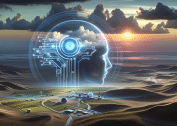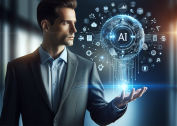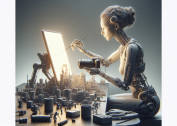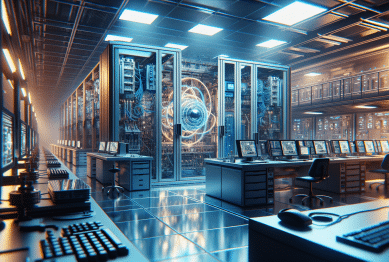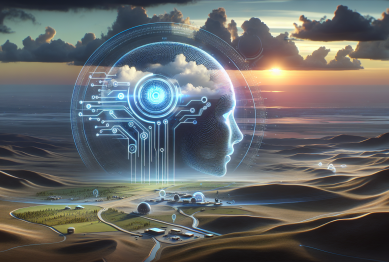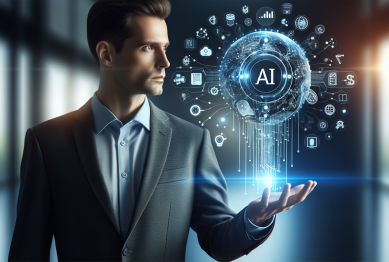Curious about artificial intelligence and the impact it has on your daily life? This article unveils how AI advances shape everything around you, from tech gadgets to healthcare, and brings surprising changes to society, work, and personal experiences. Explore AI’s power, ethics, and future possibilities inside.
The Transformative Power of AI in Everyday Tech
Artificial intelligence is at the core of many devices people use every day. Smartphones, smart speakers, and even streaming platforms rely on AI algorithms to personalize recommendations, enhance features, and make experiences more engaging. Face recognition for unlocking phones, voice assistants like Siri or Alexa, and tailored playlists on music apps – all depend on advanced machine learning processes that learn from your habits to serve you better. Everyday life feels more seamless and connected, thanks to these advancements. It’s easy to forget how much unseen technology shapes experiences until you pause and look closer.
Beyond entertainment and convenience, AI has rapidly transformed how individuals approach daily challenges. Maps and navigation apps use predictive analytics, powered by vast data, to offer real-time traffic updates. Even email inboxes are sorted using sophisticated spam filters. These systems use neural networks and deep learning, evolving as more data is processed. As a result, digital environments adapt quickly to users, anticipating needs with surprising accuracy. This smooths out frustrations, helps with decision-making, and saves time – all powered by artificial intelligence embedded invisibly in the background.
The reach of AI continues to expand as smart devices become more interconnected. The concept of the Internet of Things, where home appliances, cars, and even wearable devices communicate, wouldn’t exist without AI’s coordination. Home security, energy management, and home automation benefit tremendously from AI-driven insights. For instance, a smart thermostat learns your favorite temperature and daily schedule to optimize comfort and reduce energy bills. These changes are just the beginning, promising exponential growth in personalized, responsive technology.
Exploring Machine Learning: The Heartbeat of Modern AI
At the foundation of artificial intelligence lies machine learning, which enables computers to learn from data, recognize patterns, and improve performance without explicit programming. When you hear about AI excelling at identifying images or translating languages, it is largely machine learning at work. Algorithms process vast datasets, adapt based on feedback, and ultimately make predictions or recommendations. This approach outpaces traditional programming, which depends on fixed rules. The flexibility of machine learning allows rapid adaptation in dynamic environments, crucial for modern tech.
Machine learning comes in several forms – supervised learning, unsupervised learning, and reinforcement learning. For instance, supervised learning helps recognize handwritten numbers, while reinforcement learning is key to training AI in games or robotics. With these techniques, computers can outperform humans in specialized tasks such as diagnosing medical images or detecting fraud. A user benefits directly, often without realizing it, as email platforms or banking apps use these tools to flag suspicious activities and keep information safe.
The growing influence of data science and analytics careers reflects this shift toward machine-driven insights. Companies and research institutions invest heavily in building robust machine learning models. As these models become more sophisticated, the accuracy and effectiveness of their predictions grow, fundamentally altering how industries operate. Whether it’s improving manufacturing processes, supporting decision-making in finance, or advancing climate science, machine learning helps reveal hidden patterns and possibilities, benefiting society in diverse ways.
AI in Healthcare: Changing How You Experience Medicine
Healthcare is experiencing a major revolution as artificial intelligence enters clinics, hospitals, and research labs. Diagnostic tools based on deep learning can often spot medical issues earlier and more accurately than traditional methods. For example, AI-driven imaging systems identify subtle patterns in scans, revealing early signs of diseases such as cancer or neurological conditions. For patients and providers, this means earlier interventions and improved outcomes. These breakthroughs extend lives and contribute to more personalized medicine.
Artificial intelligence is also streamlining routine work that often burdens healthcare professionals. Natural language processing helps extract key details from medical records, while chatbots triage basic queries and automate appointment scheduling. By automating these repetitive tasks, AI frees up valuable time for clinicians to focus on direct patient care. This increased efficiency not only saves costs but also improves access and responsiveness in health systems, especially during times of high demand.
Experiments with AI-powered telehealth platforms have made specialist care more accessible, even for those in remote areas. With wearable devices, data is gathered on vital signs and lifestyle habits, providing real-time analysis and alerts for potential issues. These digital health platforms empower individuals to take a more active role in monitoring their well-being. As data accumulates, medical insights become increasingly precise, highlighting the role of AI in shaping preventive medicine and advancing public health objectives.
Understanding the Ethics and Biases in Artificial Intelligence
As artificial intelligence becomes more integrated into society, the question of ethics rises to the front. AI systems are not inherently neutral – the data used to train them can reflect biases, and decisions made by algorithms can have real-world impacts. For example, facial recognition algorithms have faced scrutiny when they misidentify people of certain backgrounds. These challenges push researchers and developers to be vigilant in how they source, train, and test AI systems. Public agencies and advocacy groups urge transparency and fairness at every stage.
Another crucial ethical concern is accountability. When a self-driving car makes a decision or when an AI algorithm influences hiring practices, determining responsibility can be complex. Ongoing debates focus on building reliable oversight, clear guidelines, and robust testing processes. Trust in AI is only possible if systems can be audited and questioned — which requires new standards and sometimes new legislation. Collaboration between tech leaders, policymakers, and ethicists is essential to guiding safe, just, and responsible advancements in AI.
Finally, concerns about privacy grow as AI systems collect and analyze massive amounts of personal data. Safeguarding sensitive information is paramount, especially in sectors like healthcare or finance. Secure data storage, anonymization techniques, and clear user consent processes must be in place to build trust. Many organizations now work with privacy advocates and cyber security experts, striving to balance innovation with the rights and expectations of individuals. The long-term future of AI will depend not only on technical capabilities but also on the industry’s commitment to ethical practice.
How AI Reshapes Careers and Skills You May Need
The rise of artificial intelligence brings opportunities for growth in many professions, but it also changes traditional roles. Automation powered by AI can handle repetitive and routine tasks across sectors like manufacturing, finance, and logistics. While this enhances efficiency, it shifts the skills that remain in demand. Jobs now often require deeper analytical abilities, adaptability, and comfort with new technologies. Resources and educational platforms offer courses on data science, coding, and machine learning – these skills help adults and students prepare for evolving career landscapes.
Some worry about job displacement due to automation, but studies show that AI also generates new roles that did not exist before. Collaboration between humans and machines leads to creative job titles – such as AI ethics officer, data curator, or machine learning engineer. Workers who upskill and stay aware of tech advancements find themselves well-positioned in emerging industries. Exploring structured online programs or blended learning opportunities makes transitioning smoother, especially with recognized training partners providing accessible certifications.
The ongoing challenge is bridging digital divides to ensure everyone benefits from progress. Employers, educators, and governments play roles in offering equitable access to skills training. Job seekers and students benefit from understanding how AI and automation interact with their fields of interest. The world of work is no longer static; adaptability, critical thinking, and the willingness to learn new tools define success in the AI era, as demonstrated by various workforce training initiatives and research-backed skill guides.
The Future of AI: Potential, Limits, and Societal Impact
The pace of artificial intelligence innovation is accelerating, opening up both tremendous promise and complex questions. Researchers predict continued breakthroughs in robotics, natural language processing, and AI-driven scientific discovery. For society, the ripple effects are vast: safer transportation, more efficient industries, new forms of creativity, and deeper insights into the world. Optimism about AI often centers on its capacity to address global challenges, from climate modeling to healthcare delivery.
Yet, limitations persist. AI is not infallible – it draws on the quality and diversity of its data, and it struggles with ambiguity or novel scenarios outside its training. Public debate surrounds how much decision-making power should be handed over to automated systems. Strategically, organizations and societies must set boundaries that ensure technology remains accountable, explainable, and aligned with human values. It’s a delicate balance that is still being explored in research labs and regulatory arenas.
Public awareness and education are key to navigating this future. By staying informed about artificial intelligence’s possibilities and constraints, individuals and communities are better equipped to influence its direction. Open dialogue among scientists, leaders, and citizens fosters a culture of responsible adoption. As AI’s presence continues to grow, its greatest impact may be fostering collective resilience, smarter societies, and a future full of new questions and possibilities.
References
1. European Commission. (n.d.). Ethics guidelines for trustworthy AI. Retrieved from https://digital-strategy.ec.europa.eu/en/library/ethics-guidelines-trustworthy-ai
2. U.S. Food & Drug Administration. (n.d.). Artificial intelligence and medical devices. Retrieved from https://www.fda.gov/medical-devices/software-medical-device-samd/artificial-intelligence-and-medical-devices
3. Stanford University. (n.d.). AI Index Report. Retrieved from https://aiindex.stanford.edu/report/
4. World Economic Forum. (n.d.). The Future of Jobs Report. Retrieved from https://www.weforum.org/reports/the-future-of-jobs-report-2023
5. Harvard University. (n.d.). The risks and opportunities of AI in healthcare. Retrieved from https://hms.harvard.edu/news/risks-and-opportunities-ai-health-care
6. National Institute of Standards and Technology. (n.d.). Artificial Intelligence Risk Management Framework. Retrieved from https://www.nist.gov/itl/ai-risk-management-framework



